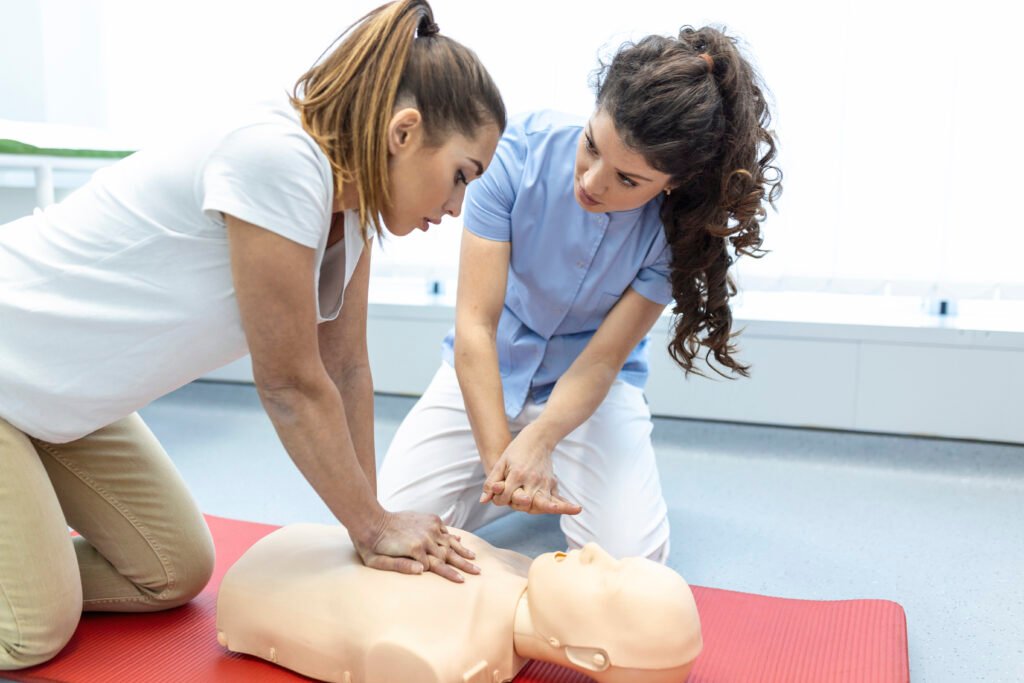Imagine this: you’re at the mall, a friend’s house, or walking down the street—and someone suddenly collapses. Would you know what to do?
In emergencies like cardiac arrest, every second counts. Waiting for an ambulance might take too long. That’s where basic CPR (Cardiopulmonary Resuscitation) can make the difference between life and death.
In this blog, we’ll explore why learning CPR is not just for doctors or healthcare workers—it’s for everyone. Whether you’re a student, parent, office worker, or business owner, knowing basic CPR could help you save a life one day.
What is CPR?
Cardiopulmonary Resuscitation (CPR) is an emergency life-saving technique used when a person’s heart stops beating or they stop breathing. It involves:
- Chest compressions to manually pump the heart
- Rescue breaths to provide oxygen (optional in hands-only CPR)
CPR keeps oxygenated blood flowing to the brain and other organs until professional help arrives or the person’s heart starts beating again.
Why is CPR So Important?
When someone has a cardiac arrest, their heart stops pumping blood. Brain cells begin to die within 4–6 minutes due to lack of oxygen. Without quick action, survival becomes nearly impossible.
CPR buys time. It keeps blood flowing and gives emergency responders a better chance of restarting the heart.
How CPR Saves Lives
-
Maintains Circulation: CPR pushes blood through the body, supplying vital organs with oxygen.
-
Buys Critical Time: It keeps the person alive until an AED (Automated External Defibrillator) or emergency services arrive.
-
Improves Survival Rate: Immediate CPR can double or triple a person’s chance of survival.
Shocking Statistics You Should Know
-
70% of out-of-hospital cardiac arrests happen at home.
-
90% of cardiac arrest victims die before reaching the hospital.
-
Brain damage starts within 4 minutes without CPR.
-
Early CPR + defibrillation within 3–5 minutes can increase survival to 50–70%.
-
Only 40% of cardiac arrest victims receive CPR from a bystander.
These numbers highlight one truth: bystander CPR saves lives.
Common Myths About CPR
Myth 1: Only medical professionals can do CPR
Reality: Anyone can—and should—learn basic CPR. You don’t need a medical degree to save a life.
Myth 2: You’ll get in legal trouble if something goes wrong
Reality: Most countries have Good Samaritan Laws that protect people who help in emergencies.
Myth 3: Mouth-to-mouth is always necessary
Reality: For adults, hands-only CPR (chest compressions only) is often enough and is widely recommended by the American Heart Association.
Myth 4: You might break their ribs
Reality: That’s possible—but it’s better than letting them die. Broken ribs can heal. Dead people can’t be revived.
Who Should Learn CPR?
- Parents – You may need to help your child or family member
- Teachers and coaches – Kids often suffer injuries or cardiac events in school or during sports
- Office employees – Cardiac arrests can happen at work too
- College students – Young, healthy people aren’t immune
- Drivers and commuters – First responders might be minutes away
- Everyone – Because emergencies don’t choose who’s around
You are someone’s first responder.
How Long Does it Take to Learn CPR?
Not long at all.
Most CPR certification courses take 2 to 5 hours. You can find:
- In-person workshops
- Online certification programs
- Free YouTube or Red Cross videos (great for hands-only basics)
Once learned, you’ll have the skill for life, and just need to refresh it every couple of years.
CPR for Adults vs. Children
While the principles of CPR are the same, there are a few important differences based on the person’s age.
| Age Group | Compressions | Rescue Breaths | Notes |
|---|---|---|---|
| Adult | 2 inches deep | Optional (Hands-only) | Use full body weight for compressions |
| Child | 2 inches deep | 30 compressions + 2 breaths | Use one hand if child is small |
| Infant | 1.5 inches deep | 30 compressions + 2 breaths | Use two fingers for compressions, gentle breaths |
It’s important to adjust your technique to avoid causing injury while still being effective.
Where to Learn CPR
There are many places where you can get trained:
Reputable CPR Training Organizations
- American Heart Association (AHA)
- Red Cross India
- St. John Ambulance
- Hospitals or Community Health Centers
- Online platforms like Coursera, Udemy, or CPR-certified sites
Free Options
- YouTube tutorials on hands-only CPR
- Community camps organized by NGOs or medical colleges
- Government health outreach programs
Bonus: How to Perform Hands-Only CPR
Here’s a quick step-by-step guide you can memorize:
- Check responsiveness: Tap and shout, “Are you okay?”
- Call for help: Dial 108 or your emergency number.
- Start compressions:
-
Place the heel of one hand on the center of the chest
-
Push hard and fast (100–120 compressions/minute)
-
Think of the beat of “Stayin’ Alive” by Bee Gees
-
-
Don’t stop until help arrives or the person begins breathing again
Final Thoughts
Learning CPR isn’t just a skill—it’s a superpower.
In just a few hours, you could equip yourself to save someone’s life—maybe a stranger, a co-worker, a friend, or even a loved one.
In a world where emergencies happen without warning, having CPR knowledge gives you control, courage, and confidence.


